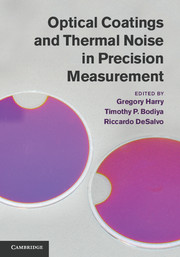Book contents
- Frontmatter
- Contents
- List of contributors
- Foreword
- Preface
- 1 Theory of thermal noise in optical mirrors
- 2 Coating technology
- 3 Compendium of thermal noises in optical mirrors
- 4 Coating thermal noise
- 5 Direct measurements of coating thermal noise
- 6 Methods of improving thermal noise
- 7 Substrate thermal noise
- 8 Cryogenics
- 9 Thermo-optic noise
- 10 Absorption and thermal issues
- 11 Optical scatter
- 12 Reflectivity and thickness optimization
- 13 Beam shaping
- 14 Gravitational wave detection
- 15 High-precision laser stabilization via optical cavities
- 16 Quantum optomechanics
- 17 Cavity quantum electrodynamics
- References
10 - Absorption and thermal issues
Published online by Cambridge University Press: 05 January 2012
- Frontmatter
- Contents
- List of contributors
- Foreword
- Preface
- 1 Theory of thermal noise in optical mirrors
- 2 Coating technology
- 3 Compendium of thermal noises in optical mirrors
- 4 Coating thermal noise
- 5 Direct measurements of coating thermal noise
- 6 Methods of improving thermal noise
- 7 Substrate thermal noise
- 8 Cryogenics
- 9 Thermo-optic noise
- 10 Absorption and thermal issues
- 11 Optical scatter
- 12 Reflectivity and thickness optimization
- 13 Beam shaping
- 14 Gravitational wave detection
- 15 High-precision laser stabilization via optical cavities
- 16 Quantum optomechanics
- 17 Cavity quantum electrodynamics
- References
Summary
Overview
Light incident on high quality optical surfaces and substrates can be lost from the beam in two possible ways. The light can be scattered from the beam due to imperfections such as microroughness or point defects, which is discussed in Chapter 11. Alternatively, the light can be absorbed by the coating or the substrates. Experiments over many decades have shown that for high quality mirrors reflecting radiation in the IR range, the dominant loss mechanism is scatter by often more than an order of magnitude. This large bias towards loss due to scatter makes it very challenging to measure the absorption in such optics. The optical absorption of the mirror coatings in high precision applications like gravitational wave interferometers (see Chapter 14) typically ranges from a fewtenths of parts per million (ppm) to several ppm. Given that the loss in mirrors is completely dominated by scatter, one may ask the question: why then is such a small level of absorption important? The reason is thermal aberrations.
Clearly, absorption at far larger than ppm levels is widely tolerated in many other types of optical instruments – metallic mirror coatings typically absorb a few percent of light incident upon them, for example. But most optical instruments are either of low power, or low precision, or both. Absorption does play a central role in setting the damage threshold intensity in high power optics. Precision measurements are typically not at such high optical power that laser damage is an issue.
- Type
- Chapter
- Information
- Optical Coatings and Thermal Noise in Precision Measurement , pp. 145 - 162Publisher: Cambridge University PressPrint publication year: 2012



